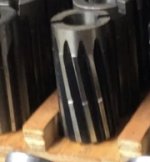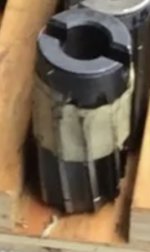Some reamers were made with a tapered nose to rough find the hole, then a non-cutting pilot diameter to make straight to the drill size, and then the reamer size to be cut. often used with a floating holder.
If so on those reamers the portion that might be the pilot diameter would
be called A circle ground diameter.
Reamer end cutting teeth should be very precisely ground or one tooth may be doing all the work, between centers or off the rear center and the nose on a bushing. Because reamers are axially fed (like a drill) the primary clearance should be perhaps 8 to 15*
Reamers usually cut /finish .0002 over the micrometer check size...and they OD taper (smaller) going back so the finish size can be adjusted smaller by cutting off the cutting end and resharpening. .0002 back taper is not uncommon, so with having this back taper to cut off 1" will make the hole .0002 smaller.
Getting hot a reamer can begin to cut .0002 (or what) larger, parts getting/being hot can cool to find the hole .0002 smaller.
For sharpening a bushing steady can be fudged up to hold the nose end, and the reamer holding bushing can be made with the same reamer that needs to be sharpened. The tooth rest finger is one that has a double end point, the longer end point rides at the reamer OD (to make solid support) and the shorter finger point to rest at the reamer flute face.....With not having the step tooth rest finger the cutting force pressure can tilt the reamer downward. It is not uncommon to up-grind .001 to remove the grinding burr.
* Reamer steady bushing can be made with CRS and last a coon's age because a remer OD is a circle grind. Good to make a dozen with a center drill hole so tha can quickly be sized on a drill press.




